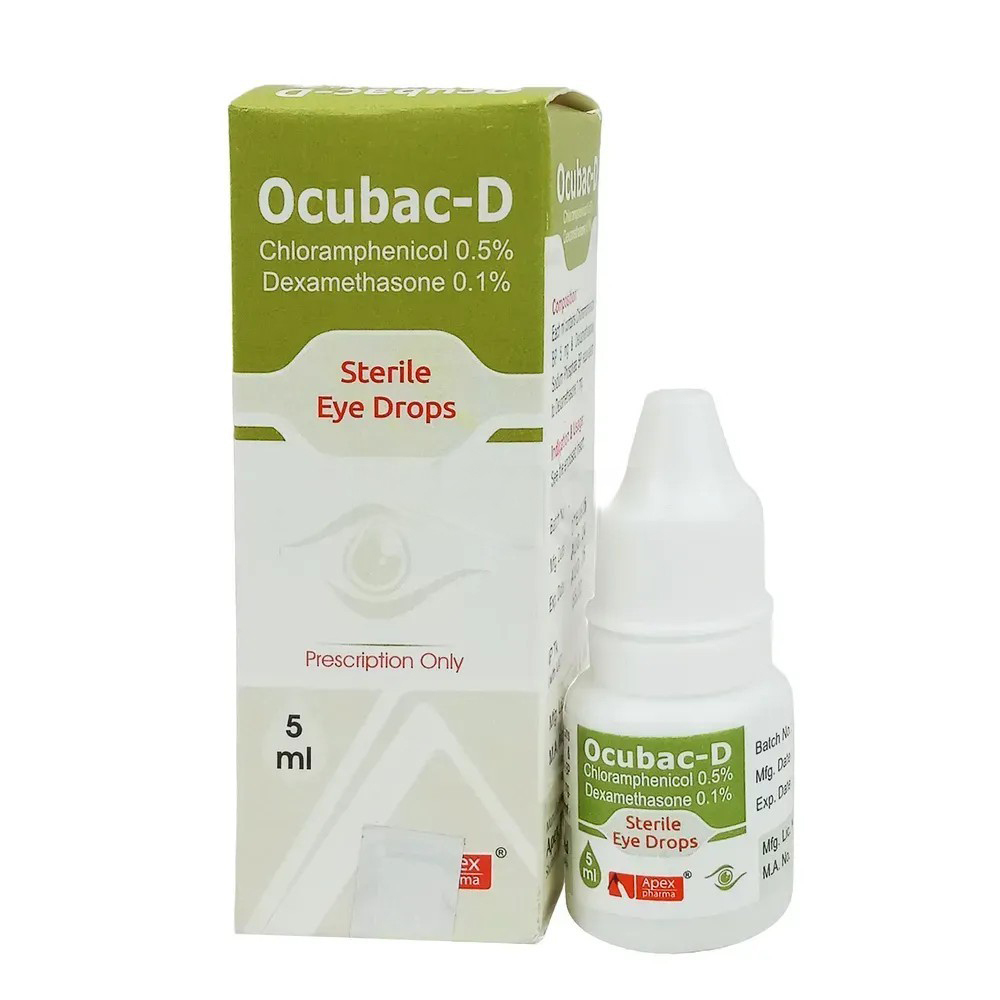Ocubac-D Ophthalmic Solution
Pack Image
0.1%+0.5%
5 ml drop:
৳ 65.00
Indications
Eye: Ocubac-D is indicated in acute purulent conjunctivitis, fresh inflammation of the superficial and deeper corneal layers and corneal ulceration. It is also used in keratitis disciformis and the more deep-seated forms of post-herpetic keratitis, allergic conjunctivitis, allergic blepharitis, acute and chronic iritis, chronic anterior uveitis and corneal injury from chemical radiation or thermal burns, or penetration of foreign bodies. The combination is used in steroid-responsive inflammatory ocular conditions for which a corticosteroid is indicated and where bacterial infection or arisk of bacterial ocular infection exists. The combination can also be used for post-operative inflammation and any other ocular inflammation associated with infection.
Ear: Ocubac-D is indicated in otitis externa, otitis media and chronic suppurative otitis media.
Ear: Ocubac-D is indicated in otitis externa, otitis media and chronic suppurative otitis media.
Pharmacology
Dexamethasone is a glucocorticoid. It has an anti-inflammatory and anti-allergic action. It is used topically in the treatment of inflammatory conditions of the anterior segment of the eye. Dexamethasone is absorbed rapidly after oral administration with a half-life of about 190 minutes. Sufficient absorption may occur after topical application to the skin and eye to produce systemic effects.
Chloramphenicol is a broad spectrum bacteriostatic antibiotic active against a wide variety of gram-negative and gram-positive organisms. Chloramphenicol exerts its antibacterial effect by binding to bacterial ribosomes and inhibiting bacterial protein synthesis at an early stage
Chloramphenicol is a broad spectrum bacteriostatic antibiotic active against a wide variety of gram-negative and gram-positive organisms. Chloramphenicol exerts its antibacterial effect by binding to bacterial ribosomes and inhibiting bacterial protein synthesis at an early stage
Dosage & Administration
Eye:
- Bacterial Conjunctivitis: The recommended dosage regimen for the treatment of bacterial conjunctivitis is 1 to 2 drops instilled into the conjunctival sac (s) every 2 hours for 2 days and 1 or 2 drops every 4 hours for the next 5(five days) while awake.
- Corneal Ulcers: The recommended dosage regimen for the treatment of comeal ulcer is 2 drops in the affected eye (s) every 15 minutes for the first 6 hours then 2 drops into the affected eye(s) every 30 minutes for the remainder of first day. On the second day, instill 2 drops in the affected eye (s) hourly. On the 3 to 14 days, place 2 drops in the affected eye (s) every 4 hours. Treatment may be continued after 14 days if corneal re-epithelialization has not occurred.
Interaction
If Chloramphenicol is absorbed from eye when taking anticoagulants e.g. warfarin, there may be an increase in the effect of this medicine. Action of Chloramphenicol will be inhibited if given simultaneously with Phenobarbital. The therapeutic efficacy of Dexamethasone may be reduced with the concomitant administration of phenytoin, phenobarbitone, ephedrine and rifampicin.
Contraindications
The combination is contraindicated in epithelial herpes simplex cornealis, fungal, viral, tuberculous and other infections of the eye and in glaucoma. Myelosuppression during previous exposure to Chloramphenicol. Hypersensitivity to Chloramphenicol & Dexamethasone Phosphate or to any other ingredients of the preparations.
Side Effects
Adverse reactions seen with Chloramphenicol are transient ocular burning or discomfort and other reported reactions include stinging, redness, itching, conjunctivitis, foreign body sensation, photophobia, blurred vision, dryness and eye pain. Allergic sensitization may occur with the local use of Chloramphenicol. Elevation of intraocular pressure with possible development of glaucoma, infrequent optic nerve damage and posterior subcapsular cataract formation.
Pregnancy & Lactation
There are no adequate and well-controlled studies in pregnant women. This drug should be used during pregnancy only if the potential benefit justifies the potential risk to the fetus. Caution should be exercised when Chloramphenicol and Dexamethasone ophthalmic solution is administered to a nursing mother.
Precautions & Warnings
The possibility of persistent fungal infections of the cornea should be considered after prolonged corticosteroid dosing. Prolonged use of steroids containing products may result in posterior subcapsular cataract formation and glaucoma with optic nerve damage. Intraocular pressure monitoring is needed. Prolonged use of antibiotics may result in the overgrowth of non-susceptible organisms, including fungi. If new infections appear during treatment, the drug should be discontinued and alternative therapy should be instituted.
Therapeutic Class
Ophthalmic steroid - antibiotic combined preparations
Storage Conditions
Keep in a cool and dry place, away from light & keep out of the reach of children. Do not use after 30 days of first opening.


